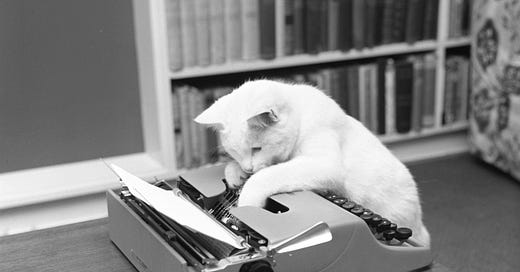I fell in love with cats only recently. Six years ago, my partner and I moved into a new neighbourhood in New Delhi known more for its stray dogs than cats, and fell completely in love with these scrappy little furry beings. One small meow at a time, these slim, small creatures competed for our attentions and affections, scooping up many of our waking hours. We’ve since then moved countries, and are now in Sweden, where we continue to run into cats on the streets, in alleyways, doorways and windows. Some have now made our place their second home, stopping by for belly rubs, games of catch, even evening snooze sessions.
Through these years, while I didn’t “own” a cat, I’ve cared for feline families, first in Delhi and now in Gothenburg, Sweden. Most of them were transitioning—from kittenhood to neighbourhood tomcat, from teenager to expectant mother, from motherhood to being out there again. But there were also three who stayed with us—Mintu, Minty and Momma. In Delhi, three had found an uncanny friendship with me, using my ground floor apartment as their daytime haven. In Delhi, my house was (in)famous for the cats that stayed, lounged and fought on the balcony, in the living room, and on the staircase. If any of them was pregnant, it was again my house and care that they’d find comfort in.
Through that time, and now, when I ascribe acute attention to cats in my life, I’ve found that reading about other writers’ relationships with them adds value to mine. I feel the pain of a writer when he writes about the death of a stray he had only barely known, or an essayist who registers the urge to take in as many of them as possible. Almost every other writer I’ve read on cats has played with Montaigne’s musing: “When I play with my cat, how do I know that she is not playing with me rather than I with her?”
Through this reading list I index some of the writers I’ve loved, disagreed with, and re-read, on the felines in their lives.
1. Lost Cat, by Mary Gaitskill; May 2019; Granta: Mary Gaitskill’s Lost Cat, which later became a small book about this seemingly small animal, is a delightful account of the loss of this scrappy little being. Through the essay, Gaitskill considers heavy subjects like pain after loss, grief, and how an animal can also be a stand-in for a close loved one.
“Six months after Gattino disappeared my husband and I were sitting in a restaurant having dinner with some people he had recently met, including an intellectual writer we both admired. The writer had considered buying the house we were living in and he wanted to know how we liked it. I said it was nice but it had been partly spoiled for me by the loss of our cat. I told him the story and he said ‘Oh, that was your trauma, was it?’ I said yes. Yes, it was a trauma.”
2. My Cat Mii; The Paris Review; By Mayumi Inaba; January, 2025: The essay catalogues the moral, philosophical, and emotional quandaries faced by the writer when she is confronted with a stray kitten in her neighborhood. The writer struggles to give the kitten a place and a name, and continues through the piece to ascribe meaning to the sudden addition of this kitten in her life.
“My cat was called simply Mii. We sometimes nicknamed her Mii-tan, but her formal name was Mii Inaba. I simply couldn’t manage to come up with a better name for her, however hard I tried. Her mew-mii, mew-mii way of crying that I’d first heard when she was hanging there in the dark had somehow stuck in my heart and wouldn’t go away.”
3. A Boat To Bilbao; Camilla Grudova; Summer 2020; The Stinging Fly: When I read this essay in January 2021, I had been having a bit of my own social interactions with stray cats around my Delhi house. Reading Grudova’s essay reaffirmed my faith in wanting to know more about these animals who had felt so alien, so other-worldly to me, until a few months ago. She names her cat Ludwig and goes on to philosophize about it at length in the essay.
“I often just say yes when people ask if he is named after Ludwig van Beethoven, because I am too crabby to explain that my ex-boyfriend named him after Ludwig Wittgenstein. Besides, I love Beethoven. Most of Wittgenstein’s philosophy is incomprehensible to me. My friend Daisy asked if I named him after Ludwig II of Bavaria, also called ‘the Swan King’, an extravagant 19th-century royal who built lots of excessive looking neo-Gothic castles. Ludwig the cat probably resembles him the most in personality, so when I am in the mood I tell people Ludwig was named after an eccentric Bavarian prince.”
4. What cats can teach us about how to live; February 2017; John Gray; New Statesman: Gray’s essay is pegged as a review of Abigail Tucker’s The Lion in the Living Room and quotes Jeffrey Masson’s The Nine Emotional Lives of Cats, the works of philosophers like Montaigne. He effuses in praise of the state of contentment of every cat, emphasising how we humans could borrow a leaf or two from their lives, and train our attention more on the now, and less of what was and will be.
“Cats initiated this process of domestication themselves, and on their own terms. Unlike other species that foraged in early human settlements, they have continued to live in close quarters with human beings ever since. For a minor predator, it is an extraordinary triumph.”
5. The Truth About Cats and Daughters; New York Times Magazine; by Jeannie Vanasco; January 2023: Not directly an essay for the “cat-person” in your life, but through this piece, Vanasco writes in detail about the direct and indirect ways in which cats mirror the behaviours, likes, and dislikes of us humans. Through this consideration it becomes very clear that cats are more like us than we’d care to acknowledge.
“You built her the ‘catio,’” she said — a pet door in the window that leads to Brooklyn’s patio, a screened-in area with platforms and an asphalt roof. “You’d think she’d be happy with that.” I thought, Should I expect you to be happy simply because I added an apartment for you? But I didn’t say that. Instead I asked if she was playing with Brooklyn regularly.
6. Ugly Cats and the Loneliness of Man; 2023 LA Review of Books; Lauren Collee: Here, Collee reflects on the history of pet pics and why we have pets after all. The essay starts with Collee’s reflection on her own pandemic pet—a grumpy cat named Hildy. As much as Collee tries to understand her, Hildy seems to be running away.
“A pet is a little walking tornado of mysteries. What does she dream about? What is she trying to tell me? What does the world look like through her eyes?”
7. “Diana’s Piano” And All The Cats I’ve Loved And Lost; Defector; By Dan McQuade; August 23: Through this essay, McQuade affectionately takes readers through the many and various stray and pet cats he’s met in his life. He shares the ways in which these cats seemed to please him and vice-versa. There’s a sense of seeing one’s own experiences in this endeavour, while also being cognizant of the very specifics of the writer’s conversation with cats.
“I see cats in every neighborhood in the city, from the suburb-like cul-de-sacs and loop streets of Far Northeast Philly (Socks, for its white paws) to alleyways in Center City (Pizza, a cat behind the cemetery on Spruce Street). I like to think that I’m a bit of a cat whisperer. I’ve had cats purr at me on a coffee farm on Hawaii’s Big Island, and at the Bronx Zoo, and inside Ott’s Exotic Plants.”






